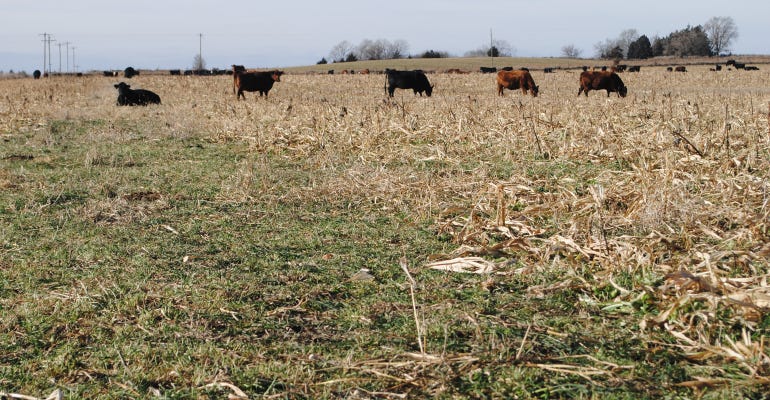
There is a lot about cover crops that we still don’t understand. Researchers and farmers will admit as much. That said, preliminary results for farmers like Doug Steffen, who began planting cover crops on his farm in northeastern Knox County in Nebraska three years ago, have been positive.
2012 was a catastrophic year for Steffen and his neighbors, due to extreme drought. Organic matter on Steffen’s farm was around 2.6% in 2012. After three years of cover crops, his organic matter climbed to 3.4% last fall. Improving soil health and increasing soil biology are the goals of Steffen’s cover crops.
“I still don’t know if the organic matter will continue to climb, or if it will level off as we continue to plant cover crops,” Steffen told participants at a recent cover crops grazing workshop. “I whole-heartedly believe in multiple species in a cover crop mixture,” he said. “I use the cover crops for grazing cattle now. I’m adding multiple species of livestock by adding sheep. Grazing these cover crops is all about a return on my investment.”
Steffen is part of a large cover crop study and soil health demonstration project being conducted by USDA Natural Resources Conservation Service across Nebraska through the Environmental Quality Incentives Program, serving as one of 17 demonstration farms implementing a soil health management system over a five-year span that began in 2016-17.
According to Aaron Hird, NRCS soil health specialist, soil health for the project can be assessed by monitoring dynamic soil properties, including soil structure characteristics, as well as standard chemical and biological lab testing.
NRCS promotes soil health through the implementation of four soil health principles:
1. disturb the soil as little as possible or not at all
2. keep the soil covered
3. maintain a living root in the soil as much of the year as possible, or throughout the year
4. add diversity to the system or increase the different kinds of plants and animals that use the soil
Through this network of cover crop demonstration farms, the University of Nebraska agronomy and horticulture departments, Nebraska Extension On-farm Research Network, NRCS and farmers are comparing various factors related to cover crops. This includes planting a monoculture of cover crops like rye compared to multiple species in a mixture, or drilling cover crop seed compared to broadcast-seeding.

OVERCOMING CHALLENGES: While watering cattle and maintaining electric fencing during heavy deer populations has been challenging in grazing cover crops, Steffen believes in the soil-building properties of cover crops and the long-term benefits to soil health.

Grazing cover crops for Steffen hasn’t been without challenges. The fields where he has grazed cover crops do not have water access, so he has been hauling water daily for 130 cows through the fall and winter grazing season. Steffen and his family have installed miles of electric fencing, which at times has been challenged by deer and cattle. He mentioned that fencing for sheep will be an added challenge that he is still working on.
The obstacles and challenges haven’t thwarted Steffen’s resolve. He cites an increase in beneficial insects and spiders in his fields, a multitude of earthworms and their castings, and a change in overall soil structure as reasons for optimism after only three seasons of planting cover crops and grazing.
His seed mixtures, planted in August after a cash crop of wheat or field peas, have changed over the years. For the past two years, the mixtures have included sunflower and safflower, some species of sorghum or millet, oats, buckwheat, legumes, and brassicas.
Steffen says he has tried to improve the timing of planting because earlier-planted seed offers more grazing biomass in the fall and winter and starts faster in the spring. For Steffen, the idea of cover crops is not only feeding the soil microbes under the ground, but also building what he called “armor for the soil,” which can infiltrate rain from extreme weather events and vastly reduce soil erosion while still providing an economic return.
About the Author(s)
You May Also Like






